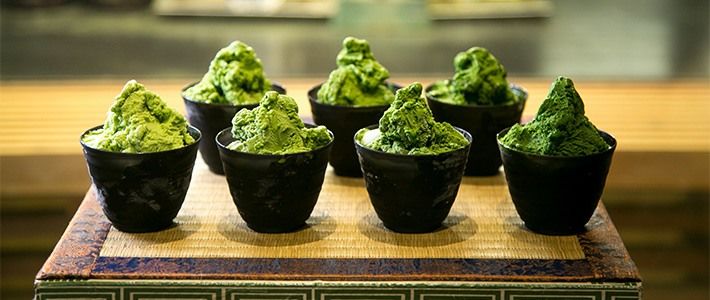
Modernizing “Matcha”: Can Innovation and Gelato Revitalize Japan’s Tea Industry?
Guideto Japan
Food and Drink Guide to Japan Travel Culture- English
- 日本語
- 简体字
- 繁體字
- Français
- Español
- العربية
- Русский
Fans of matcha-flavored sweets have good reason to make a special trip to Nanaya in Fujieda, Shizuoka Prefecture, one of Japan’s premier tea-growing districts. Launched in 2010 by Suzuki Shigehiko, eighth-generation owner of tea wholesaler Marushichi Seicha, Nanaya showcases gelato and chocolates featuring the inimitable flavor and aroma of Fujieda matcha.
Suzuki recalls the frustration that initially motivated his venture. “Everyone associates matcha with Uji in Kyoto,” he laments. “Fujieda matcha is Uji-cha’s equal in quality and price, but it just doesn’t have the name recognition. Our own locals didn’t recognize the quality of the matcha we produced here. Through a process of trial and error, I settled on matcha-flavored sweets as the best way to communicate that quality to my customers.”
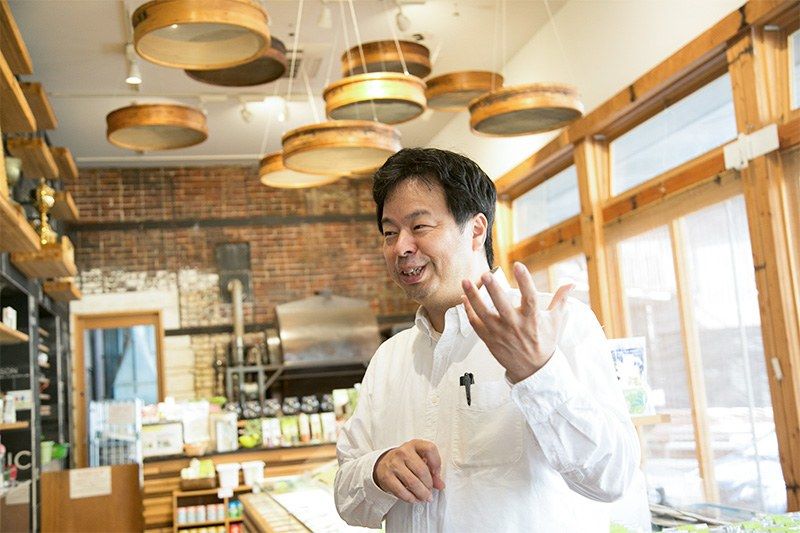
Suzuki Shigehiko, eighth-generation owner of Marushichi Seicha, at his retail store Nanaya.
Seven Shades of Matcha
Suzuki’s experience in advertising (as a university student, he was involved in an advertising study circle and completed an internship at an advertising agency) stood him in good stead in his new venture. He realized that he needed a unique value proposition in order to build a dominant brand, especially in today’s world of information overload. “In the era of social media, it’s hard to stand out from the crowd unless you can claim to be the best at something,” he says. With that in mind, he set out to create the world’s most intense matcha-flavored gelato.
In fact, Nanaya offers seven shades of matcha gelato, numbered 1 through 7, from mildest to strongest. (No. 1 and No. 2 are about the same intensity as the packaged matcha ice cream available commercially.) Concentrating the matcha flavor presented some technical challenges, however. Suzuki got as far as No. 5 before he was told by a gelato expert that he had probably reached the limit; the gelato-mixing machine simply could not handle any more matcha.
But Suzuki was undeterred. For him, seven was the magic number: In addition to echoing the name of the family business, it symbolized the full spectrum of choice, like the colors of the rainbow. After extensive experimentation, he came out with No. 6 and, finally, Premium No. 7—known as the world’s strongest matcha gelato.
The palatability of Nanaya’s super-strong matcha gelato is testimony to the quality of its star ingredient, Fujieda matcha. The flavor of matcha comes through more clearly in gelato than in conventional ice cream, owing to gelato’s lower milk-fat content. Unless made with the highest-quality matcha, a super-intense gelato like No. 7 would immediately overwhelm the palate with bitterness. Nanaya’s spinach-green No. 7 is rich yet smooth, with the same vegetal complexity and lingering sweet aftertaste of fine matcha. It is now Nanaya’s signature product and top seller.
Suzuki’s marketing strategy was a resounding success. Talk of the “world’s strongest matcha gelato” spread over social media, and before long it was the subject of TV and magazine features. Now customers routinely line up for a taste of the product, not only at the Fujieda flagship store but also at Nanaya’s more recently opened Tokyo and Kyoto locations.
Suzuki’s next goal is to conquer and expand the international market for tea-infused chocolate. In September 2018, his hōjicha- and matcha-infused chocolate bars won silver and bronze medals, respectively, at the Asia-Pacific competition of the International Chocolate Awards. In early November, Nanaya exhibited a brand-new selection of dairy-free craft chocolates (made solely of cocoa butter, sugar, and tea) at the Salon du Chocolat in Paris, the world’s biggest chocolate trade fair. Featuring eight pairs of tea-infused sticks—seven shades of matcha and one of hōjicha—the product was a huge hit with visitors, despite its price tag of 20 euros for 72 grams of chocolate.
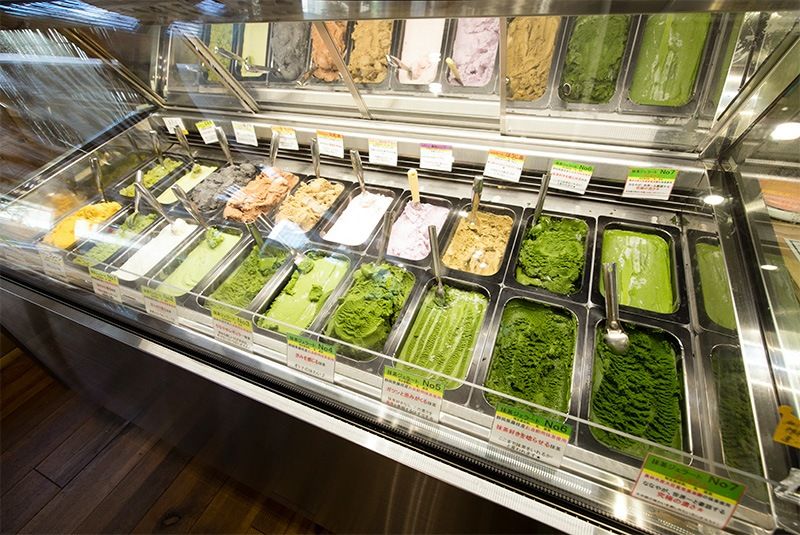
Nanaya features 20 flavors of gelato, including hōjicha and Japanese black tea, as well as seven shades of matcha.
A Brief History of Fujieda Matcha
Fujieda was once famous for its gyokuro tea, a special high grade of shade-grown sencha (green leaf tea). By the 1970s, however, changing consumer preferences and price competition from more strategically located farm communities were sapping the local gyokuro industry of vitality. About 30 years ago, the local growers turned to Suzuki Masami, Shigehiko’s father, for advice. Masami was president of Marushichi Seicha, the local tea processor and wholesaler that purchases most of the raw tea produced in Fujieda. Alert to market trends, Masami advocated a shift from gyokuro to tencha, the tea used to make powdered matcha.
Tencha is made from the same variety of tea as standard sencha. The difference lies in the method of cultivation, harvesting, and processing. Like gyokuro, tencha is covered for at least 20 days before harvesting to shield the leaves from direct sunlight. The shade causes the leaves to produce more chlorophyll (resulting in a deep green color) and increases the concentration of the amino acid theanine. Immediately after harvesting, the leaves are steamed briefly to prevent oxidation and air-dried. Then they are gently heat-dried in special ovens. The dried tea leaves are carefully sorted, refined, blended, and finally stone-ground to a fine powder to make matcha.
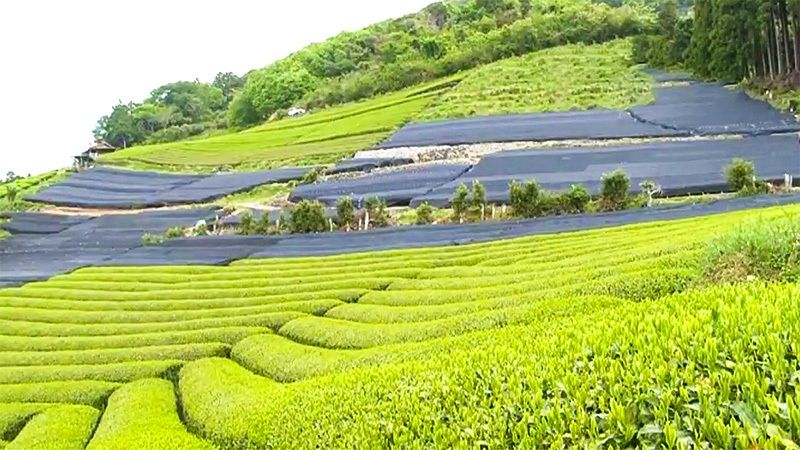
A Fujieda tea plantation with a portion of the crop covered by sheets to produce shade-grown tencha. (© Marushichi Seicha)
Tencha had never been produced in Shizuoka Prefecture before, and the transition was more difficult than anticipated. Marushichi Seicha took the lead, organizing the local producers into more than 100 small cooperatives, training their personnel, and purchasing their tencha, even though it took several seasons for them to produce matcha-quality tea leaves. For the first few years, Marushichi struggled under a heavy burden of debt.
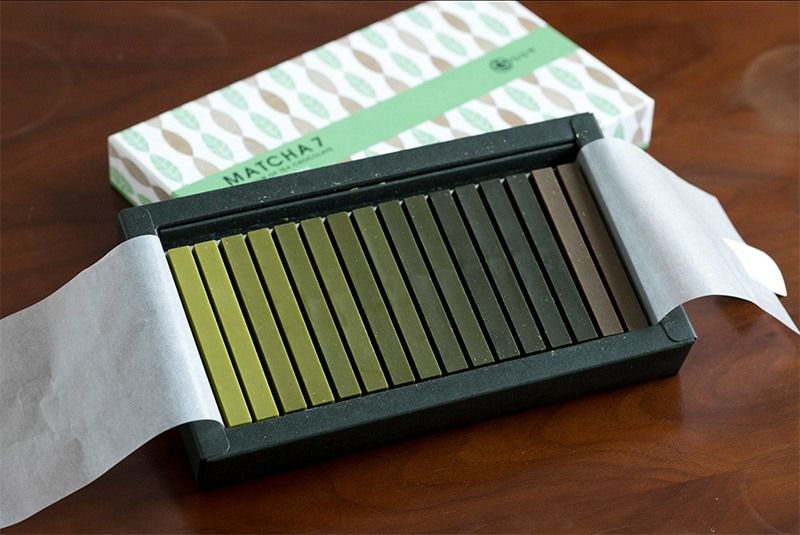
Nanaya’s “Matcha 7” craft chocolate selection, exhibited at the 2018 Salon du Chocolat in Paris.
An Industry in Decline
Nowadays fans of green tea in general and matcha in particular are legion, both in Japan and around the world. Coffee shops feature matcha latte, restaurants serve matcha tiramisu, high-end pastry shops offer matcha cake . . . the list goes on and on. Suzuki has skillfully ridden this global wave. As a whole, however, Japan’s tea industry has been less successful in adapting to a changing world.
Domestic production of green tea has declined in recent years despite the growth in global demand. Aging tea farmers have been retiring in increasing numbers with no one to succeed them. One reason for the exodus of young farmers is price competition from abroad. As green tea’s global popularity has surged, overseas producers and merchants have jumped into the market with cheaper products, including low-grade matcha and even powdered sencha masquerading as matcha.
“Japan has these quality products that should be able to hold their own in the global marketplace,” says Suzuki. “But without effective branding, we’ll never persuade the world that those products are worth the higher price.”
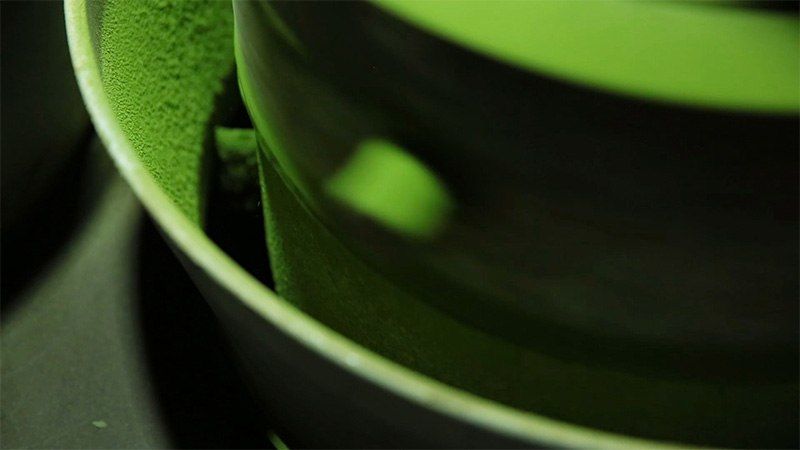
High-quality shade-grown tencha leaves are slowly stone-ground to a fine powder to make matcha. (© Marushichi Seicha)
Although committed to quality and tradition, Suzuki cautions that hard work and traditional craftsmanship are not enough to sustain the Japanese tea industry in the twenty-first century. Lifestyles and tastes have changed. To survive, the industry must embrace new, scientifically proven technologies and adapt its products to the evolving needs and tastes of today’s consumers. Suzuki sponsors frequent workshops to educate producers and promote creative innovation.
With fierce price competition undermining the profitability of tea farming, Suzuki believes that the industry as a whole must change to retain the next generation of farmers. This means focusing less on loose tea for direct sale to consumers and more on tea for processing purposes, pouring effort and ingenuity into the development and marketing of high-value-added matcha products.
As an example, Suzuki is contemplating a line of extra-strong matcha-infused chocolates targeting office workers and others wanting a tasty respite from the rat race. “Green tea has two ingredients that act in seemingly opposite ways,” he explains. “It has caffeine, which is a stimulant, but it also has theanine, which is calming.” I think matcha helped the warriors of the Sengoku period master their fear of death and go into battle calm but alert.” Suzuki believes that matcha can offer similar benefits for modern-day “corporate warriors” facing important meetings or presentations.
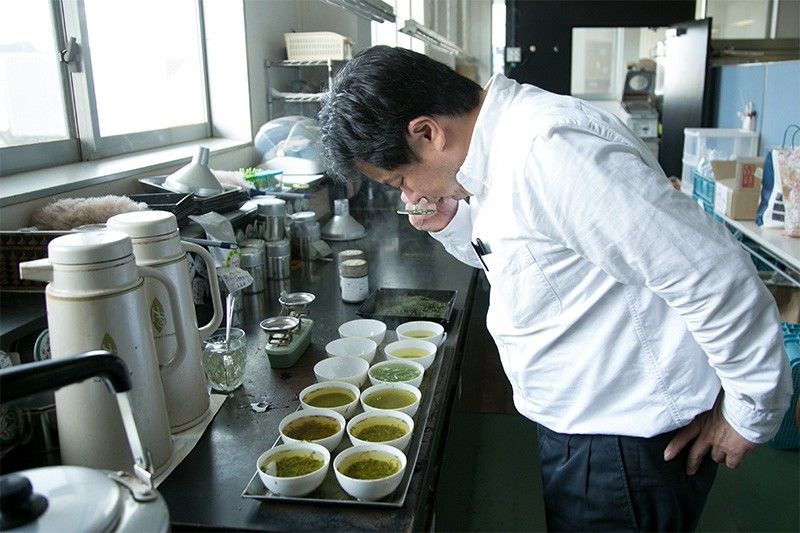
At Marushichi Seicha, samples of tea are tested on a daily basis to monitor their content and quality.
The Future of Matcha
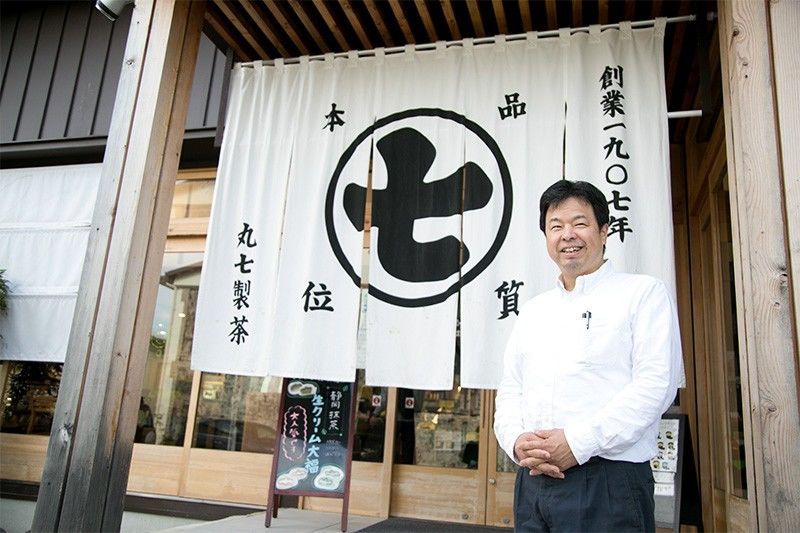
Suzuki in front of his flagship store Nanaya. The noren is emblazoned with the character for seven (nana or shichi), a component of the company and brand names. Marushichi Seicha was founded in 1907.
The structure of the domestic tea market has changed markedly over the past few decades. There was a time when every Japanese office kept its own supply of loose green tea, from which low-ranking employees (generally women) would brew fresh tea in a teapot to serve at meetings. “That’s hard to ask nowadays,” laughs Suzuki. On the other hand, demand continues to grow for high-quality bottled green tea.
As Suzuki sees it, opportunity abounds. “We live in a time when even a small provincial company can spread the word about its products via the Internet,” he notes. “As someone born and raised in this community, I’m constantly thinking about the region’s unique assets and ways to communicate them to the rest of the world.”
On most mornings, Suzuki can be found in Marushichi Seicha’s main plant, assiduously checking and tasting samples of the dried tea leaves—more than 100 grades and types altogether—sent there from other facilities for processing. Drawing on his tea memory and extensive blending experience, he has personally designed a wide range of blends tailored to every taste and purpose. This know-how and commitment to quality, seamlessly integrated with creative entrepreneurship, modern marketing savvy, and a commitment to the local community, have found expression in Nanaya’s incomparable Fujieda matcha gelato and chocolate.
(Originally written in Japanese. Banner photo: Nanaya’s seven shades of matcha gelato. All photos by Kawamoto Seiya, unless otherwise stated. )
Marushichi Seicha Co., Ltd.
Nanaya Fujieda
- Address: 141-1 Uchiseto, Fujieda, Shizuoka 426-0076
- Tel: 054-646-7783
- Hours: 10 am to 6 pm
- Closed Wednesdays, except on national holidays